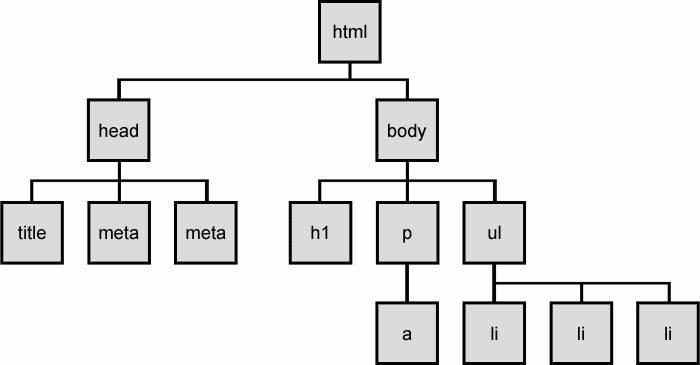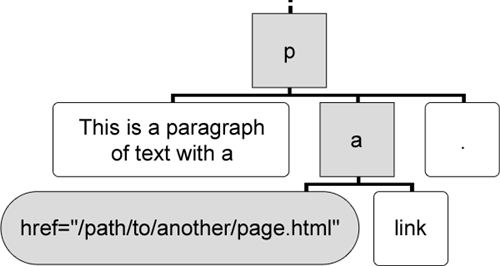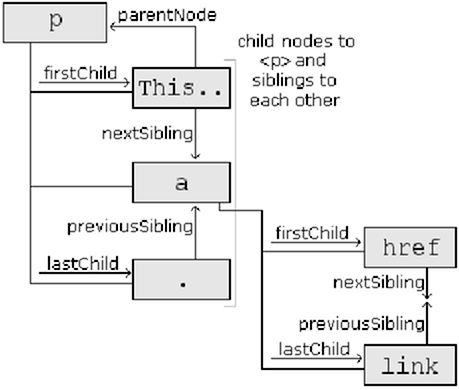Document Object Model (DOM)
CSE 190 M (Web Programming), Spring 2007
University of Washington
References: Forbes/Steele, Chipman (much of this content was stolen from them)
Except where otherwise noted, the contents of this presentation are © Copyright 2007 Marty Stepp and are licensed under the Creative Commons Attribution 2.5 License.
Recall: Document Object Model (DOM)

- a representation of the current web page as a tree of Javascript objects
- allows you to view/modify page elements in script code after page has loaded
- client side = highly responsive interactions
- browser-independent
- allows progressive enhancement of pages
- also used for XML parsing, which we'll do soon
An example XHTML page
<!DOCTYPE html PUBLIC "-//W3C//DTD XHTML 1.0 Strict//EN" "http://www.w3.org/TR/XHTML1/DTD/XHTML1-strict.dtd"> <html xmlns="http://www.w3.org/1999/XHTML" xml:lang="en" lang="en"> <head> <title>Page Title</title> <meta http-equiv="content-type" content="text/html; charset=utf-8" /> <meta http-equiv="Content-Language" content="en-us" /> </head> <body> <h1>This is a heading</h1> <p>A paragraph with a <a href="http://www.google.com/">link</a>.</p> <ul> <li>a list item</li> <li>another list item</li> <li>a third list item</li> </ul> </body> </html>
The resulting DOM tree

Types of nodes
<p>This is a paragraph of text with a <a href="/path/to/another/page.html">link</a> inside.

 element nodes (HTML tag)
element nodes (HTML tag)
- can have children and/or attributes
 text nodes (text in a block element)
text nodes (text in a block element)
- a child within an element node
- cannot have children or attributes
 attribute nodes (attribute/value pair inside the start of a tag)
attribute nodes (attribute/value pair inside the start of a tag)
- a child within an element node
- cannot have children or attributes
Traversing the DOM tree
every node's DOM object has the following properties:
firstChild,lastChild: start/end of this node's list of childrenchildNodes: array of all this node's childrennextSibling,previousSibling: neighboring nodes that have the same parentparentNode: the element that contains this node
DOM tree traversal example
<p id="foo">This is a paragraph of text with a <a href="/path/to/another/page.html">link</a> inside.

- How would we change the word "link" in the above HTML to be "bunny"?
Modifying the DOM tree
Every DOM node object has these methods:
appendChild(node): places the given node at the end of this node's child listinsertBefore(newChild, oldChild): places the given new node in this node's child list just beforeoldChildremoveChild(node): removes the given node from this node's child listreplaceChild(newChild, oldChild): replaces the given child node with the given new node
Creating new nodes: createElement
// create a new <h2> node var newHeading = document.createElement("h2"); newHeading.style.color = "green"; newHeading.innerHTML = "This is a heading"; // put it onto the page in the div with id "content" var contentArea = document.getElementById("content"); contentArea.appendChild(newHeading);
document.createElement("tag")constructs a new empty DOM node representing an element of that type- this node's properties can be set just like any other DOM node's
- once appropriate properties are set, the node can be added to the page
Modifying tree example
// in window.onload event handler,
document.getElementById("thisslide").onclick = slideClick;
function slideClick() {
var p = document.createElement("p");
p.innerHTML = "A paragraph!";
this.appendChild(p);
}
DOM versus innerHTML
Why not just code the previous example this way?
// equivalent to previous slide, but worse style
function slideClick() {
this.innerHTML += "<p>A paragraph!</p>";
}
Ugly innerHTML code
Imagine that the new node is more complex:
function slideClick() {
this.innerHTML += "<p style='color: red; " +
"margin-left: 50px;' " +
"onclick='myOnClick();'>" +
"A paragraph!</p>";
}
- ugly as hell
- must carefully distinguish
"and' - bad style on many levels (style and JS code embedded within HTML)
- can only add at beginning or end, not in middle of child list
Benefits of DOM over innerHTML
function slideClick() {
var p = document.createElement("p");
p.style.color = "red";
p.style.marginLeft = "50px";
p.onclick = myOnClick;
p.innerHTML = "A paragraph!"; // here innerHTML is okay
this.appendChild(p);
}
- cleaner to attach event handlers to DOM object
- cleaner to set styles on DOM object
- still okay to use
innerHTMLif a node's inner contents are trivial
Practice problem: Rectangles
Click a rectangle to move it to the front. Shift-click a rectangle to delete it.
----- More DOM -----
More DOM features
Accessing nodes by id or tag
document.getElementById("id")
- gets a specific element on the page
element.getElementsByTagName("tag")
- get an array of all children of the given type (
"p","div", etc.) - can be called on the overall
documentor on a specific node
Getting all elements of a certain type
highlight all paragraphs in document
var allParas = document.getElementsByTagName("p");
for (var i = 0; i < allParas.length; i++) {
allParas[i].style.backgroundColor = "yellow";
}
<body>
<p>This is the first paragraph</p>
<p>This is the second paragraph</p>
<p>You get the idea...</p>
</body>Combining with getElementById
highlight all paragraphs inside of the section with ID "footer"
var footer = document.getElementById("footer");
var footerParas = footer.getElementsByTagName("p");
for (var i = 0; i < footerParas.length; i++) {
footerParas[i].style.backgroundColor = "yellow";
}
<p>This won't be returned!</p>
<div id="footer">
<p>1234 Street</p>
<p>Atlanta, GA</p>
</div>Global DOM objects
Every Javascript program can refer to the following global objects:
The window object
- represents the entire browser window
- the top-level object in the DOM hierarchy
- technically, all global variables become part of the
windowobject - methods:
-
alert,blur,clearInterval,clearTimeout,close,confirm,focus,moveBy,moveTo,open,print,prompt,resizeBy,resizeTo,scrollBy,scrollTo,setInterval,setTimeout
-
- properties:
The navigator object
- information about the web browser application
- properties:
The screen object
- information about the client's display screen
- properties:
The history object
- list of sites the browser has visited in this window
- properties:
- methods:
- complete list
The location object
The document object
- represents the URL of the current web page
- properties:
- methods:
- complete list

